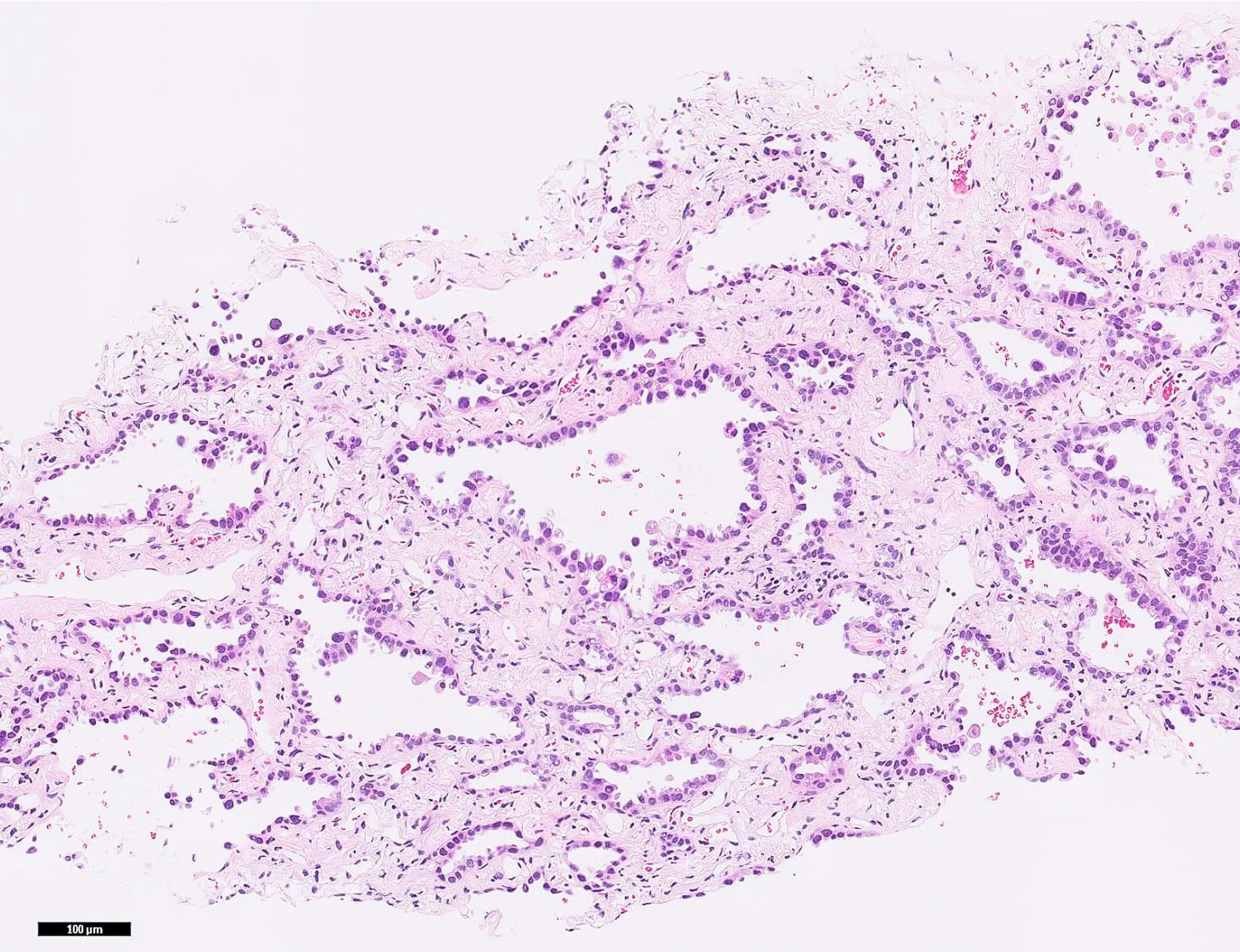Table of Contents
Definition / general | WHO (2015) | Major updates | Board review style question #1 | Board review style answer #1 | Board review style question #2 | Board review style answer #2Cite this page: Bychkov A. WHO classification. PathologyOutlines.com website. https://www.pathologyoutlines.com/topic/lungtumorWHO.html. Accessed April 19th, 2024.
Definition / general
- Terminology of lung tumors has been significantly revised in the 2015 WHO classification (Travis: WHO Classification of Tumours of the Lung, Pleura, Thymus and Heart, 4th Edition, 2015)
- These changes are subsequent to the 2011 Association for the Study of Lung Cancer / American Thoracic Society / European Respiratory Society (IASLC / ATS / ERS) Classification (Semin Thorac Cardiovasc Surg 2014;26:210)
WHO (2015)
WHO classification of tumors of the lung (Travis: WHO Classification of Tumours of the Lung, Pleura, Thymus and Heart, 4th Edition, 2015)
-
Epithelial tumorsICD-O codes
- Adenocarcinoma 8140/3
- Lepidic adenocarcinoma 8250/3
- Acinar adenocarcinoma 8551/3
- Papillary adenocarcinoma 8260/3
- Micropapillary adenocarcinoma8265/3
- Solid adenocarcinoma8230/3
- Invasive mucinous adenocarcinoma8253/3
- Mixed invasive mucinous and nonmucinous adenocarcinoma 8254/3
- Colloid adenocarcinoma 8480/3
- Fetal adenocarcinoma8333/3
- Enteric adenocarcinoma 8144/3
- Minimally invasive adenocarcinoma
- Nonmucinous 8256/3
- Mucinous8257/3
- Preinvasive lesions
- Atypical adenomatous hyperplasia 8250/0
- Adenocarcinoma in situ8140/2
- Nonmucinous8250/2
- Mucinous8253/2
- Squamous cell carcinoma8070/3
- Keratinizing squamous cell carcinoma8071/3
- Nonkeratinizing squamous cell carcinoma8072/3
- Basaloid squamous cell carcinoma8083/3
- Preinvasive lesion
- Squamous cell carcinoma in situ8070/2
- Neuroendocrine tumors
- Small cell carcinoma8041/3
- Combined small cell carcinoma8045/3
- Large cell neuroendocrine carcinoma8013/3
- Combined large cell neuroendocrine carcinoma8013/3
- Carcinoid tumors
- Typical carcinoid8240/3
- Atypical carcinoid8249/3
- Preinvasive lesion
- Diffuse idiopathic pulmonary neuroendocrine cell hyperplasia8040/0
- Small cell carcinoma8041/3
- Large cell carcinoma8012/3
- Adenosquamous carcinoma8560/3
- Pleomorphic carcinoma8022/3
- Spindle cell carcinoma 8032/3
- Giant cell carcinoma8031/3
- Carcinosarcoma8980/3
- Pulmonary blastoma8972/3
- Other and unclassified carcinomas
- Lymphoepithelioma-like carcinoma8082/3
- NUT carcinoma8023/3
- Salivary gland type tumors
- Mucoepidermoid carcinoma8430/3
- Adenoid cystic carcinoma8200/3
- Epithelial myoepithelial carcinoma8562/3
- Pleomorphic adenoma8940/0
- Papillomas
- Squamous cell papilloma8052/0
- Exophytic8052/0
- Inverted8053/0
- Glandular papilloma8260/0
- Mixed squamous and glandular papilloma8560/0
- Squamous cell papilloma8052/0
- Adenomas
- Sclerosing pneumocytoma8832/0
- Alveolar adenoma8251/0
- Papillary adenoma8260/0
- Mucinous cystadenoma8470/0
- Mucous gland adenoma8480/0
- Pulmonary hamartoma8992/0
- Chondroma9220/0
- PEComatous tumors
- Lymphangioleiomyomatosis9174/1
- PEComa, benign8714/0
- Clear cell tumor8005/0
- PEComa, malignant8714/3
- Congenital peribronchial myofibroblastic tumor8827/1
- Diffuse pulmonary lymphangiomatosis
- Inflammatory myofibroblastic tumor8825/1
- Epithelioid hemangioendothelioma9133/3
- Pleuropulmonary blastoma8973/3
- Synovial sarcoma9040/3
- Pulmonary artery intimal sarcoma9137/3
- Pulmonary myxoid sarcoma with EWSR1-CREB1 translocation8842/3
- Myoepithelial tumors
- Myoepithelioma8982/0
- Myoepithelial carcinoma8982/3
- Extranodal marginal zone lymphoma of mucosa associated lymphoid tissue (MALT lymphoma)9699/3
- Diffuse large B cell lymphoma9680/3
- Lymphomatoid granulomatosis9766/1
- Intravascular large B cell lymphoma9712/3
- Pulmonary Langerhans cell histiocytosis9751/1
- Erdheim-Chester disease9750/1
- Germ cell tumors
- Teratoma, mature9080/0
- Teratoma, immature9080/1
- Intrapulmonary thymoma8580/3
- Melanoma8720/3
- Meningioma, NOS9530/0
- ICD-O note: behavior is coded: /0 for benign tumors; /1 for unspecified, borderline, or uncertain behavior; /2 for carcinoma in situ and grade III intraepithelial neoplasia; and /3 for malignant tumors
Major updates
- Conceptual changes (J Thorac Oncol 2015;10:1243)
- Use of immunohistochemistry throughout the classification
- New emphasis on genetic studies, in particular, integration of molecular testing to help personalize treatment strategies for advanced lung cancer patients
- New classification for small biopsies and cytology similar to that proposed in the 2011 IASLC / ATS / ERS classification
- Changes in terminology and diagnostic criteria (J Thorac Oncol 2015;10:1243)
- Revised classification of lung adenocarcinoma
- Restricted the diagnosis of large cell carcinoma only to resected tumors that lack any clear morphologic or immunohistochemical differentiation with reclassification of the remaining former large cell carcinoma subtypes into different categories
- Reclassified squamous cell carcinomas into keratinizing, nonkeratinizing and basaloid subtypes with the nonkeratinizing tumors requiring immunohistochemistry proof of squamous differentiation
- Grouped neuroendocrine tumors in a single category
- Added NUT carcinoma
- Changed the term sclerosing hemangioma to sclerosing pneumocytoma
- Changed the name hamartoma to pulmonary hamartoma
- Created a group of PEComatous tumors that include (a) lymphangioleiomyomatosis, (b) PEComa, benign (with clear cell tumor as a variant) and (c) PEComa, malignant
- Introduced the entity pulmonary myxoid sarcoma with an EWSR1-CREB1 translocation
- Added the entities myoepithelioma and myoepithelial carcinomas, which can show EWSR1 gene rearrangements
- Recognition of usefulness of WWTR1-CAMTA1 fusions in diagnosis of epithelioid hemangioendotheliomas
- Added Erdheim-Chester disease to the lymphoproliferative tumor and group of tumors of ectopic origin to include germ cell tumors, intrapulmonary thymoma, melanoma and meningioma
Board review style question #1
- Which new entity has been added in the 2015 WHO classification of lung tumors?
- Adenosquamous carcinoma
- MALT lymphoma
- NUT carcinoma
- Sclerosing hemangioma
- Hyalinizing granuloma
Board review style answer #1
C. NUT carcinoma. NUT midline carcinoma is a recently recognized highly aggressive tumor defined by a NUT fusion. Being exceptionally rare in the lung, it was introduced in the 2015 WHO classification of lung tumors. Adenosquamous carcinoma and MALT lymphoma are in the WHO classification but not new entities in the 2015 edition. Sclerosing hemangioma is an outdated term; this tumor has been recently renamed to sclerosing pneumocytoma. Hyalinizing granuloma is an inflammatory lesion, not a tumor.
Comment Here
Reference: Lung - WHO classification
Comment Here
Reference: Lung - WHO classification
Board review style question #2
Board review style answer #2
C. Lepidic. Lepidic adenocarcinoma consists of neoplastic cells growing along the surface of alveolar walls (lepidic pattern) with no architectural disruption and no lymphovascular / pleural invasion. It was formerly known as bronchioloalveolar carcinoma (obsolete term).
Comment Here
Reference: Lung - WHO classification
Comment Here
Reference: Lung - WHO classification





